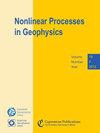Superstatistical analysis of sea surface currents in the Gulf of Trieste, measured by high-frequency radar, and its relation to wind regimes using the maximum-entropy principle
IF 2.4
4区 地球科学
Q3 GEOSCIENCES, MULTIDISCIPLINARY
引用次数: 0
Abstract
Abstract. Two years (2021–2022) of high-frequency-radar (HFR) sea surface current data in the Gulf of Trieste (northern Adriatic Sea) are analysed. Two different timescales are extracted using a superstatistical formalism: a relaxation time and a larger timescale over which the system is Gaussian. We propose obtaining an ocean current probability density function (PDF) combining (i) a Gaussian PDF for the fast fluctuations and (ii) a convolution of exponential PDFs for the slowly evolving variance of the Gaussian function rather than for the thermodynamic β=1/σ2 in a system with a few degrees of freedom, as the latter has divergent moments. The Gaussian PDF reflects the entropy maximization for real-valued variables with a given variance. On the other hand, if a positive variable, as a variance, has a specified mean, the maximum-entropy solution is an exponential PDF. In our case the system has 2 degrees of freedom, and therefore the PDF of the variance is the convolution of two exponentials. In the Gulf of Trieste there are three distinct main wind forcing regimes: bora, sirocco, and low wind, leading to a succession of different sea current dynamics on different timescales. The universality class PDF successfully fits the observed data over the 2 observation years and also for each wind regime separately with a different variance of the variance PDF, which is the only free parameter in all the fits.高频雷达测量的的里雅斯特湾海流的超统计分析及其与使用最大熵原理的风态的关系
摘要。本文分析了两年(2021-2022)的里雅斯特湾(亚得里亚海北部)高频雷达(HFR)海面流数据。使用超统计形式提取两个不同的时间尺度:一个松弛时间和一个更大的时间尺度,其中系统是高斯的。我们提出了一个海流概率密度函数(PDF),结合(i)快速波动的高斯概率密度函数和(ii)高斯函数缓慢变化方差的指数概率密度函数的卷积,而不是对具有几个自由度的系统的热力学β=1/σ2的卷积,因为后者具有发散矩。高斯PDF反映了具有给定方差的实值变量的熵最大化。另一方面,如果一个正变量,作为一个方差,有一个指定的平均值,最大熵解是一个指数PDF。在我们的例子中,系统有两个自由度,因此方差的PDF是两个指数的卷积。在的里雅斯特湾,有三种不同的主要风强迫机制:强风、强风和低风,导致了不同时间尺度上不同海流动力学的连续变化。通用性类PDF成功地拟合了2个观测年的观测数据和每个风期的观测数据,方差PDF是所有拟合中唯一的自由参数。
本文章由计算机程序翻译,如有差异,请以英文原文为准。
求助全文
约1分钟内获得全文
求助全文
来源期刊

Nonlinear Processes in Geophysics
地学-地球化学与地球物理
CiteScore
4.00
自引率
0.00%
发文量
21
审稿时长
6-12 weeks
期刊介绍:
Nonlinear Processes in Geophysics (NPG) is an international, inter-/trans-disciplinary, non-profit journal devoted to breaking the deadlocks often faced by standard approaches in Earth and space sciences. It therefore solicits disruptive and innovative concepts and methodologies, as well as original applications of these to address the ubiquitous complexity in geoscience systems, and in interacting social and biological systems. Such systems are nonlinear, with responses strongly non-proportional to perturbations, and show an associated extreme variability across scales.
 求助内容:
求助内容: 应助结果提醒方式:
应助结果提醒方式:


